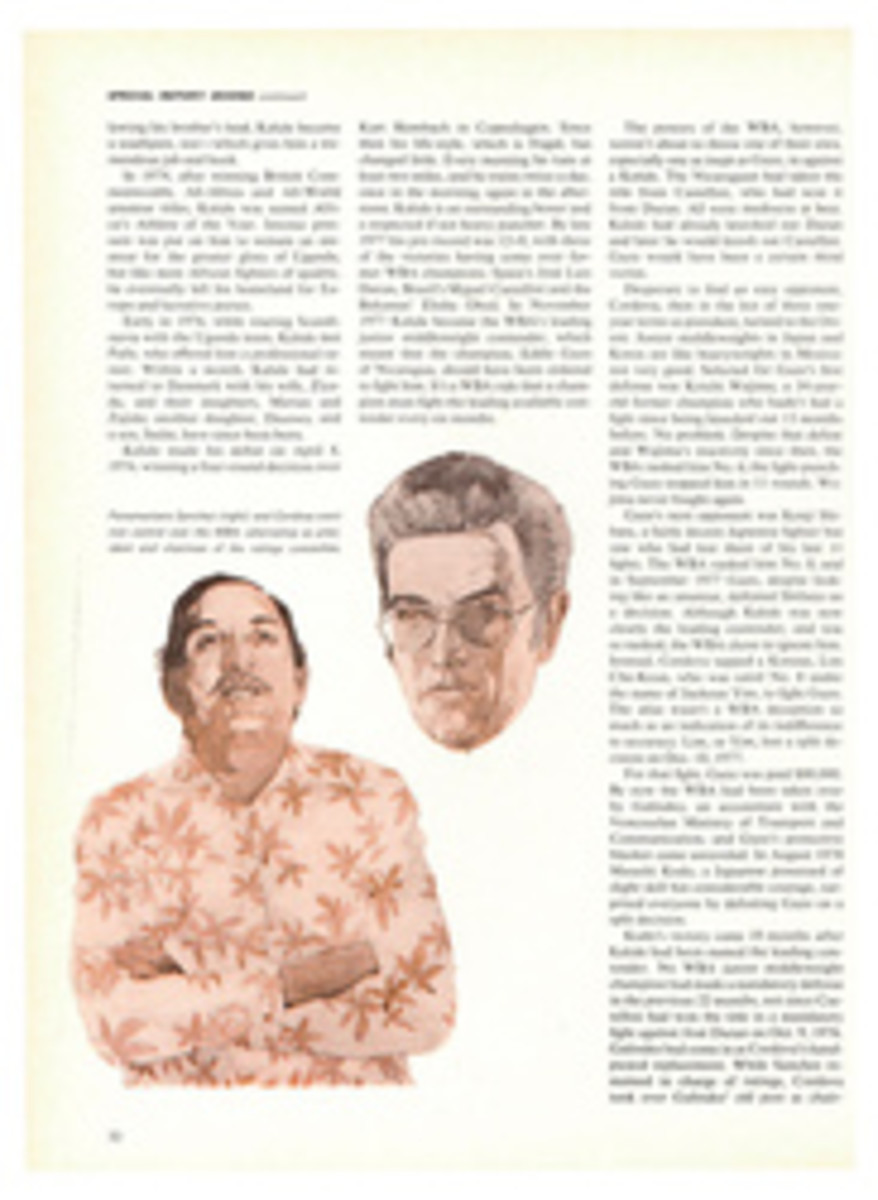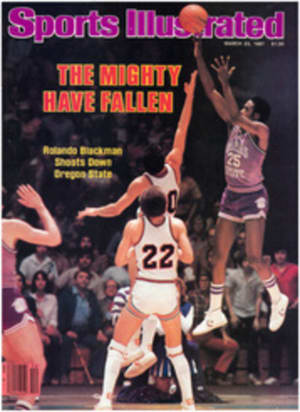
What a one-horse stable!
Many people who visit a racetrack a few times get the itch to buy a horse and get into the game. For most, the costs are prohibitive, starting, of course, with the price of the horse itself. Then it takes, on the average, $40 per day per horse to keep it going at a top track, and that does not include veterinary work, shoeing, shipping, licensing or jockey fees. And after all that, the odds against a horse ever winning a major stakes race are more than in 60,000-1.
Had you bought a yearling named Canadian Bound in 1976, you would have made a terrible mistake; this $1.5 million son of Secretariat had such a terrible case of the slows that it never ran a race. Had you been very, very lucky that year, however, you might have purchased little John Henry for $1,100. If so, you would now own the leading active money-earner ($1,525,730) in the sport.
John Henry represents the entire racing stock of a New York City couple, Dorothy and Sam Rubin, owners of the Dotsam Stable. On Presidents' Day last month the 6-year-old bay gelding, returning after a three-month layoff, ran a marvelous race on Santa Anita's lush turf course to win the 1½ mile, $107,800 San Luis Obispo Handicap just as he pleased. Two weeks ago John Henry came off the grass and won the $418,150 Santa Anita Handicap, defeating Flying Paster and Glorious Song. When John Henry appeared in the winner's circle, the crowd of 66,560 gave him a huge ovation. Californians have grown to love that horse.
As indeed they should. Since November 1979 John Henry has run in nine major stakes at either Santa Anita or Hollywood Park and won them all. And with style. A year ago in the $200,000 San Juan Capistrano, America's most important turf race, John Henry led every step of the 1¾ miles while shouldering top weight of 126 pounds. Last fall he fell far off the pace in the Oak Tree Invitational, then drove through the stretch to win in the final yards. He came from seventh to win the Santa Anita 'Cap.
Unlike Spectacular Bid, who placidly munched jelly doughnuts. John Henry can be "meaner than a junkyard dog." He has tossed exercise riders in the morning, thrown jockeys in the afternoon and bitten numerous people at various times of the day. John Henry's two trainers—V.J. (Lefty) Nickerson in the East, and Ron McAnally in the West—have learned to saddle the horse with its rear end toward the crowd because John wants nothing to do with most people. That applies to the Rubins. "A year ago," Sam Rubin says, "I went to his stall at Hialeah, and when I looked inside I couldn't see him. I thought someone had stolen him. I stuck my head in and hollered, 'John, you in there?' He was hiding off to the left, and when my head went into that stall he nearly tore it off."
In 1980 John Henry won $925,217, the bulk of it for running through "the weeds," and was named the nation's top grass horse. He ran on dirt only once last year, finishing second to Temperence Hill in the $500,000 Jockey Club Gold Cup at Belmont.
Naturally, John Henry is expected to spend most of this season on the turf; his next two races—the $150,000 San Luis Rey and the $200,000 San Juan Capistrano, both at Santa Anita—will be on grass. He was the first horse nominated for the Arlington $1 Million in Chicago in August. Rubin is also eyeing major turf races in Japan and Australia for his tough little warrior." "I'd love to win the race at Arlington," he says, "and then go to another country to race him, but to be honest, I don't know that much about racing. I'm a horseplayer who got lucky with his only horse. Because of John Henry, when I go to the races in New York now, people follow me around. They say, 'There goes Sam Rubin. He owns John Henry. He must know something.'' Sometimes those horseplayers follow me for nine races and never cash a ticket. What Sam Rubin knows best is bicycles." Sam is the president of the Sam Rubin Bicycle Corp., importer of the South Korean Kia bike.
Rubin, 67, can go on and on about how little he knows about horses. "Do you know how John Henry was sent to California to do so well?" he asks. "John had been racing in New York, and the grass season was coming to an end because of the weather. Lefty Nickerson told me that there were big grass races out there and said he had a close friend, Ron McAnally, who was an excellent trainer. I needed advice on what to do and wasn't too sure where to get it. Instead of going to Alfred Vanderbilt or Dinny Phipps, I went to Cohen Johnson, who has the binocular concession at the New York tracks. I asked Johnson what to do and he said, 'Mr. Rubin, you send John Henry to California, and McAnally and the horse will do good.' It was excellent advice."
How John Henry got to the Rubins is a fascinating tale. In the two months between November 1975 and January 1976, three horses from the same family were sold in Lexington. John Henry, a yearling, brought $1,100. His sire, 13-year-old Ole Bob Bowers, was sold for $900, and his mother, Once Double, for $5,000. A smart investor could have gotten all three for less than the $7,000 they actually cost. The family was considered a bunch of duds.
While John Henry and Once Double remained in Kentucky, Ole Bob Bowers was vanned to Beechwind Farms in Osseo, Mich, by his new owners, Charlie and Theora Crommer. "We had gone to Lexington to buy a stallion," says Theora, "and we were ready to bid as much as $5,000. We liked Ole Bob Bowers and made the the only bid on him at $900. I think everyone laughed at us when we left the sales pavilion."
Ole Bob, now 18, had the reputation of being a decent grass horse with a vicious temper. His main claim to fame was a race on dirt at Bay Meadows, the 1968 Tanforan Handicap. A layer of discarded mushroom compost had been put on the rack to make it fast, and Ole Bob Bowers ran over those mushrooms as if his heels were aflame, tying the world record of 1:46[2/5] for 1‚Öõ miles. That win is remembered as The Mushroom Miracle. In 1977 the stallion serviced 22 mares at Beechwind for a stud fee of $500 apiece. Thanks to John Henry's prowess, Ole Bob was bred to 79 mares last year at $1,200 per service. Still, even at $900 Ole Bob was nowhere near the bargain buy John Henry was.
A year after John Henry was sold for $1,100, he was resold for $2,200. The buyer, Harold Snowden Jr. of Fairfield Farm at Lexington, Ky., quickly found out how mean John Henry could be. John would bite and kick and sometimes stick his feet into the feed tub and knock it off the stall wall. Snowden arranged for John Henry to be sold to a Mrs. Akiko McVarish for $7,500. but Mrs. McVarish's vet took one look at the horse and decided he could never stand training, so Snowden took John Henry back and got him ready for the races.
Enter now two ladies from Louisiana—Mrs. Colleen Madera of New Orleans and her racing-stable partner, Mrs. Dortha Lingo of Baton Rouge. Snowden sold John Henry to them for $10,000. Now gelded, John Henry began his racing career at Jefferson Downs in Kenner, La. and won at first asking in a four-furlong race, picking up a check for $1,200. After losing his next three starts, he caught a sloppy track at Evangeline Downs and won again. Then, in his last race of 1977, in the. slop at Evangeline, he won the $86,450 Lafayette Futurity.
This made the Louisiana ladies very happy. John Henry, however, was not happy. Not happy at all. In the spring of 1978 he lost his first six starts. The horse was now so mean that a volleyball was put into his stall in hopes that he would kick it, not the barn walls. Placed in claiming races for $20,000 to $25,000, he had no takers. This made the Louisiana ladies very unhappy, so they asked Snowden to sell John Henry once again.
Enter Sam Rubin, who paid $25,000 for the gelding. "Back in the middle '60s I owned some horses," Rubin says, "but they were bums. Dot and I decided maybe we ought to get back into racing and buy a horse. I thought I might have a decent kind of claiming horse or maybe an allowance horse. But you never know. I was hoping allowance."
On a May afternoon at Aqueduct in 1978, John Henry ran for the first time for Dotsam Stable and won, lighting the tote board up at $26.60 for each $2 bet. And Sam Rubin rarely bets only $2. While that Aqueduct race had been on dirt, Rubin noticed that the same day's feature race was the Fort Marcy Handicap on turf. That got him thinking. Ten days later John Henry ran on grass for the first time and won a claiming race by 14 lengths at Belmont Park. Luckily for the Rubins, nobody put in a claim slip for the $35,000 price.
Since that first turf race, John Henry has run on the grass 29 times and turned most of those races into lawn parties, winning 16, including a dozen stakes. The San Luis Obispo victory drove John Henry's grass winnings to $1,056,682, surpassing Fort Marcy's U.S. turf record by $9. The little horse who went through eight owners and was rejected by countless others in claiming races may not care much for people, but racetrack fans have come to love him a lot.
PHOTO
In the San Luis Obispo, John Henry led the field of six from wire to wire and won by 1½ lengths.
PHOTO
The track's binoculars man helped Rubin put things in focus.

